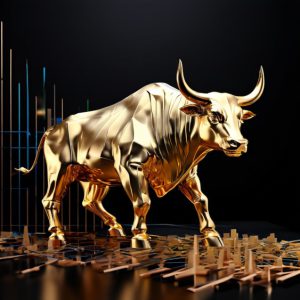
April 24, 2024
Why Did the Stock Market Crash: The Same Time-Tested Reason
Introduction: An Unsettling Question
Black Monday, 1987 – The Precursor
Delving into the annals of financial history, the stock market crash of 1987, famously labelled Black Monday, emerges as a defining moment. This economic disruption sent shockwaves as the Dow Jones Industrial Average witnessed an astonishing 22.6% plunge daily. The question that echoes through time is why such a seismic event unfolded.
Economists scrutinize the roots of Black Monday, attributing the crash to a potent cocktail of factors. Overvaluation loomed large as stock prices soared to unsustainable heights, creating a precarious imbalance in the market. The reliance on computerized trading, a relatively novel phenomenon at the time, exacerbated the situation. Automated trading systems, programmed to respond swiftly to market fluctuations, amplified the speed and intensity of the sell-off.
Amidst this financial maelstrom, an intangible yet powerful force played a pivotal role—the prevailing atmosphere of high anxiety among traders. Fear and uncertainty gripped the market participants, influencing their decisions and actions. The human element, with emotions running high, became a driving force behind the cascade of selling, contributing to the unprecedented scale of the crash.
As the smoke of Black Monday began to clear, it left an indelible mark on the financial landscape. The event was a stark reminder of the vulnerabilities inherent in a market driven by human psychology and technological innovations. The aftermath prompted a reassessment of risk management strategies and a closer examination of the interconnectedness of global financial markets.
The Dot-Com Bubble Burst, 2000 – When Virtual Reality Clashed with Financial Reality
It was zooming ahead to the early 2000s, and a new chapter in financial history unfolded, marked by the dot-com bubble burst. The question that surfaces is: What led to the stock market crash during the era of dot-com euphoria? This period, characterized by a surge in technology-related investments, was marred by overinvestment in internet-based companies, a phenomenon driven by unrealistic growth expectations and a speculative frenzy.
An unprecedented wave of enthusiasm for internet-related businesses fueled the dot-com boom. Investors, caught in the allure of the digital frontier, poured substantial capital into companies, often overlooking traditional valuation metrics. The prevailing sentiment was boundless optimism, fueled by the belief that the internet would reshape industries and generate astronomical profits.
Amid this enthusiasm, the concept of “eyeballs” became a buzzword—a metric used to measure the number of visitors to a website. Investors and analysts, enamoured by the internet’s potential, valued companies based on user engagement rather than tangible financial performance. This departure from conventional valuation methods created a speculative bubble, where stock prices soared to unsustainable levels.
As the dot-com bubble expanded, the financial landscape witnessed a surge in technology companies’ initial public offerings (IPOs). The rush to invest in these offerings, often of companies with unproven business models, further fueled the speculative fervour. The market became a breeding ground for companies with lofty promises but little substance.
The turning point arrived when the market began to sober up from the dot-com euphoria. Investors, who had once embraced the virtual potential of these companies, started demanding tangible results. As the reality of unsustainable business models set in, a wave of sell-offs ensued. Stock prices plummeted, and the dot-com bubble burst, leaving a trail of bankruptcies and financial losses.
The Subprime Meltdown, 2008 – A House of Cards
Transitioning into the first decade of the 21st century, the global financial landscape encountered a seismic event—the 2008 global economic crisis. The question arises: What triggered the stock market crash during this period? A nuanced exploration unveils a multifaceted scenario characterized by reckless lending practices, the securitization of subprime mortgages, and the failure of rating agencies to assess risk accurately. This intricate web of factors played a pivotal role in the catastrophic collapse of the housing market, setting the stage for the ensuing financial turmoil.
At the heart of the crisis were the reckless lending practices that permeated the housing market. Financial institutions, driven by a quest for higher profits, extended mortgage loans to borrowers with questionable creditworthiness. The allure of immediate gains blinded lenders to the long-term risks associated with subprime lending. These high-risk loans formed the foundation of a precarious financial structure, setting the stage for the eventual unravelling of the market.
Compounding the issue was the securitization of subprime mortgages. Financial institutions bundled these risky mortgages into complex financial products and sold them as securities to investors. The complexity of these financial instruments masked the inherent risks, creating a false sense of security among investors. As the subprime mortgage market began to crumble, these securities, once considered safe, revealed their true nature, triggering a cascade of financial losses.
Equally significant was the failure of rating agencies to accurately assess the risk associated with these complex financial products. Trusted with the task of providing independent evaluations, these agencies assigned high ratings to securities backed by subprime mortgages, further perpetuating the misconception of their safety. The disconnect between the perceived and actual risk amplified the shockwaves of the impending crisis, as investors relied on flawed assessments in their decision-making processes.
As the cracks in the housing market deepened, the impact reverberated throughout the global financial system. The interconnectedness of financial institutions, fueled by the widespread distribution of subprime-related securities, transformed the localized housing crisis into a full-blown global financial meltdown. The stock market, a barometer of economic health, bore the brunt of the problem as investor confidence crumbled, leading to widespread panic and a sharp decline in stock prices.
In the aftermath of the 2008 financial crisis, regulators and policymakers embarked on a journey to address the systemic issues that had precipitated the meltdown. Reforms were implemented to enhance oversight of financial institutions, and efforts were made to strengthen risk management practices. The scars of the subprime collapse are a stark reminder of the far-reaching consequences that can arise from a convergence of reckless lending, financial complexity, and regulatory shortcomings.
The Covid Crash, 2020 – The Pandemic Blow
Embarking on the most recent chapter of our financial exploration, we delve into the question: Why did the stock market crash in the wake of a global health crisis? The catalyst for this unprecedented event was the rapid and unrelenting spread of Covid-19, which triggered an economic standstill. The pandemic-induced measures, including widespread lockdowns and social distancing protocols, brought businesses to a grinding halt, leading to a surge in unemployment rates. In this volatile atmosphere, the financial markets found themselves in the eye of the storm, experiencing a swift and severe downturn.
The Covid-19 pandemic introduced an element of uncertainty that transcended typical economic indicators. The market, driven by investor sentiment and real-time developments related to the pandemic, became highly reactive. As news of the virus’s spread and its impact on global economies unfolded, investors grappled with the unknown, resulting in heightened fear and anxiety.
The sectors most directly affected by the pandemic, such as travel, hospitality, and entertainment, faced unprecedented challenges. With restrictions in place and consumer behaviour shifting, these industries experienced sharp revenue declines, prompting a domino effect throughout the broader economy. The interconnectedness of global supply chains and markets exacerbated the impact, as disruptions in one part of the world reverberated globally.
Governments worldwide responded with stimulus measures to mitigate the economic fallout. Central banks enacted policies to stabilize financial markets, inject liquidity, and implement interest rate adjustments. While providing a semblance of stability, these measures also underscored the severity of the economic challenges. The effectiveness of these interventions became a subject of intense scrutiny as markets continued to fluctuate in response to both the progression of the pandemic and the evolving policy landscape.
Technology emerged as a resilient force during the crisis, pivotal in sustaining economic activities. Remote work and digital communication technologies became lifelines for businesses, allowing them to adapt to the new normal. The tech sector, characterized by its ability to innovate and thrive in adversity, experienced a surge in investor interest, offsetting broader market declines.
The Covid crash also prompted a reevaluation of traditional investment strategies. Investors sought refuge in assets perceived as safer havens, such as gold and certain government bonds. The quest for stability and preservation of capital became paramount as market participants navigated the unpredictable waves of the pandemic-induced economic turmoil.
Conclusion: Mass Psychology and Market Dynamics
As we conclude our exploration into why the stock market crash occurred at these historical junctions, we stumble upon a common thread: mass psychology. From the anxiety-ridden traders of 1987 to the speculative frenzy of the dot-com era and from the reckless optimism of 2008 to the pandemic-induced fear in 2020, investor psychology has played a pivotal role in these market crashes.
Much like any social system, the stock market is a manifestation of collective human behaviour. In times of crisis, fear and panic can rapidly spread through the market, leading to a selling frenzy. Conversely, unchecked optimism can inflate asset prices to unsustainable levels during prosperity, setting the stage for a potential crash.
To understand why the stock market crash occurred, we must delve deeper into the realm of mass psychology. Although unconventional, this approach offers a fresh perspective on financial market dynamics. It compels us to view the market not merely as a numerical entity but as a living organism pulsating with the collective emotions of its participants.
Ultimately, the question “Why Did the Stock Market Crash?” transcends the realm of economics and finance. It beckons us into the fascinating world of human behaviour, urging us to question, explore, and understand the intricate dance between psychology and market dynamics.
Diverse Perspectives: Compelling Viewpoints

Mastering Emotional Control for Successful Stock Market Investing

Preferred Stock Market Valuation Is Based Primarily Upon

Mastering Options Trading: Unveiling the Real Secrets

Which of the Following Is an Example of Collective Behavior?

4X ETF: Deadly Risks and Realities

SPY 200-Day Moving Average Strategy: Learn, Earn, and Prosper

CPNG Share Price: Buy, Sell, or Hold?

Rolling Over Options: The Ultimate Guide to Mastery

Dow 30 Stocks with Dividends: A Winning Strategy for Income Investors

Collective Behavior Generally Takes Which of the Following Forms?

Harnessing Collective Behavior: Strategies for Investment Success

Unlocking Value in Equal-Weighted Index Funds: Benefits and Strategies

What Caused the 1987 Stock Market Crash: Could It Happen Again?

Active vs Passive Investors – The Power of Discipline



